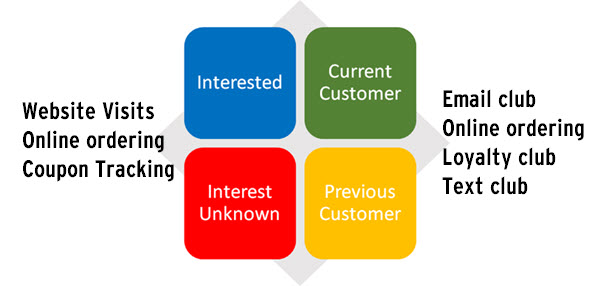This is the sixth post in a comprehensive series on How to advertise your restaurant on Facebook.
For Chains with Hundreds of Locations to Single Unit restaurants – This series will change the way you advertise.
Part 1: How to advertise on Facebook – Building Your Custom Audiences
Part 2: How to advertise on Facebook – Audience Insights – Understanding Who Are Your Ideal Customers
Part 3: How to advertise on Facebook – Lookalike Audiences – Targeting Similar Customers
Part 4: How to advertise on Facebook – Custom Audiences – Targeting Specific Interest
Part 5: How to advertise on Facebook – Custom Audiences – Remarketing
Part 6: How to advertise on Facebook – Addressing Your Biggest Digital Advertising Challenges
Getting great advertising results boils down to targeting the right audience with the right message at the right time.

In Part 1: How to advertise on Facebook – Building Your Custom Audiences we detailed how to build your custom audiences in Facebook to understand who are your customers and who are the people that are interested in eating at your restaurant but have not visited yet.
In Part 2 We looked at how to use Facebook Audience Insights to analyze your current customers and interested prospects to identify who are your ideal customers and develop buyer personas.
In Part 3: How to advertise on Facebook – Lookalike Audiences – Targeting Similar Customers we looked at how to use lookalike audiences to target new customers with Facebook Ads.
In Part 4: How to advertise on Facebook – Custom Audiences – Targeting Specific Interest we we looked at how to segment your current customers even further to create targeted Facebook Ads to smaller audiences with specific interests.
In Part 5: How to advertise on Facebook – Custom Audiences – Remarketing we looked at how to use the advertising technique named Remargeting which is commonly used in retail.
In Part 6: How to advertise on Facebook – Addressing Your Biggest Digital Advertising Challenges we will look at how Facebook Advertising allows you address restaurant marketing’s biggest challenges.
Restaurant Marketing’s Biggest Challenges
The biggest challenges in restaurant marketing are:
- Making a direct connection between the campaign and an in-store visit.
- Attracting new customers with promotions without cannibalizing existing sales.
- Minimizing wasted advertising dollars
Today the Facebook advertising tools exist to address your biggest challenges and to provide you with the data and information you need to know that a customer visited your restaurant as a direct result of your campaign.
Below is a recap of the tools and how you can build a Facebook advertising system that will allow you to to address your biggest digital marketing challenges.
Building Your Audiences
In Part 1 we showed you how you can identify everyone that is connected directly to your business with customer lists and everyone that is locally interested in your business just by tracking what the customer has viewed online using the Facebook Ad pixel.

In Facebook these are just some of the target audiences you can build:
- Email club members
- Loyalty club members
- Registered online ordering customers
- Text club members
- People interested in your restaurant
- People that have looked at specific pages on your website
- New customers
- Customers that have viewed your online ordering
- Customers that have viewed a coupon
- Customers that have redeemed a coupon
Identifying Your Ideal Customers
In Part 2 we showed you how to build Buyer Personas of your ideal customers. Using Facebook’s Audience Insights you can compare any audience against the profiles of Facebook users. Audience Insights will give you better understanding of your ideal audiences including their demographics, interests, buying patterns, income levels.
For example, you could analyze an audience of your most loyal customers to identify common characteristics and interests in order to target potential new customers that closely match your current loyal customers.
A restaurant may have several different types of ideal customers depending on their offerings. The key is to identify the Buyer Personas of the different types of customers.
For example you might have the following Buyer Personas:
– Loyal Customer Andrew
– Happy Hour Kelly
– Organic Kathy
– Discount Dave
– Online Ordering Carrie
– Occasional Visitor Foster
Analyze your Facebook custom audiences to build Buyer Personas that are representative of your customers. If you currently do not have custom audience data, the fastest way to gather the information is to start tracking the website visits of your customers and potential customers.
Targeting the Right Audience
The biggest waste of advertising dollars is to target audiences that are not interested in your type of restaurant.
Suppose you want to drive business with new customers. If you already have a custom audience of current customers then you can use this audience to identify people that have similar characteristics and interests.
In Part 3 we showed you how to use Facebook Lookalike audiences as a way to create an audience of new customers who are likely to be interested in your restaurant. The more custom audiences you have with specific interests the more you will be able to create lookalike audiences with similar interests.
To get the most from your advertising dollars when attracting new customers target the appropriate Lookalike audience and exclude current customers from seeing the ad. That will ensure that only people that do not know about your restaurant will see your ad.
Driving Specific Revenues
For many restaurants there are specific areas of their business where they want to increase revenues.
For example, restaurants may want to increase:
- Lunch time sales
- Sales on Mondays and Tuesdays
- Early bird sales
- Happy Hour sales
- Buffet sales
- Online ordering sales
In Part 4 we showed you how adding tracking codes to categorize your coupons allows you to build Facebook custom audiences with specific interests. For example, every customer that views a Happy Hour coupon can be added to a custom audience that is interested in Happy Hour promotions.
Your email marketing can help you create these audiences with specific interests. The tracking codes in your coupons sent via your email marketing messages will add customers that click on the coupons to Facebook custom audiences. Categorize coupons and create associated Facebook custom audiences for as many target interest groups that make sense for your restaurant.
In the future when you want to increase specific revenues you can target an audience that you know is interested with a Facebook ad.
Specific targeting can be particularly effective for restaurant chains where the interested audience can be relatively small on a location level but in aggregate the audience can represent thousands of customers with the same interest.
Targeting smaller interested audiences will also minimize advertising spend and put the ads in front of the right audience. You should expect higher click through percentages and higher ad relevance scores with these ads.
You can also track coupon redemptions and identify the customers that actually used the coupon for the targeted interest area. This allows you to directly attribute the coupon redemption to the specific ad campaign.
Getting New Customers to Try Your Restaurant
Many potential customers first look at your website menu when deciding if they want to eat at your restaurant. It is not unusual for people to select someplace else to eat even though they would be interested in giving your restaurant a try at some point.
In part 5 we showed you how to use an advertising technique named, “Remarketing”. Remarketing is commonly used by online retail websites that get thousands of visitors that will translate only into a small number of buyers.
Retailers understand that it is important to keep their marketing message in front of website visitors to get them to return to the site and make a purchase. What retailers do is create audiences that have looked at specific products on their website and then after they have visited put an advertising message in front of the visitor for the exact item they have looked at.
That same technique can be used by restaurants when website visitors have viewed pages like the menu, online ordering, or gift cards. It can also be used for coupon offers where a customer has viewed a specific offer and has not stopped in to redeem it as of yet.
As you know there is a ton of marketing noise in the world. Remarketing is one way to cut through the clutter and put a specific ad in front of a customer or website visitor and give them a little nudge to stop in and eat.
| You can download all six parts of the 41-page Restaurant Facebook Advertising Guide by Clicking Here |
